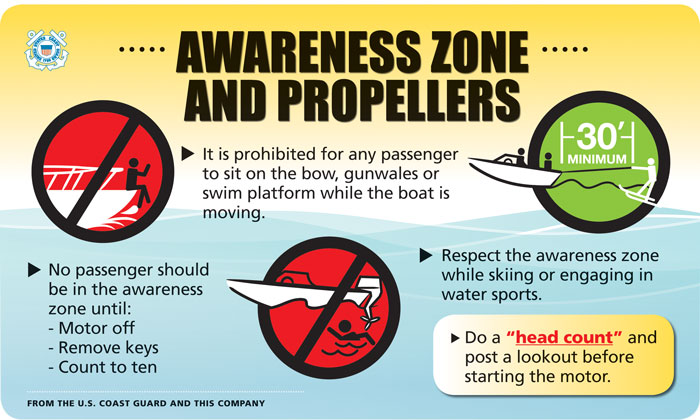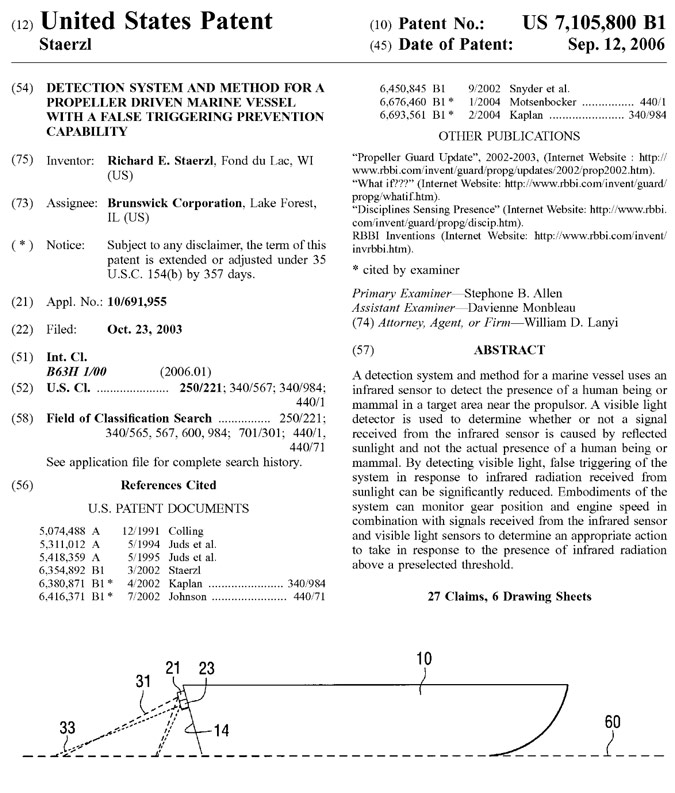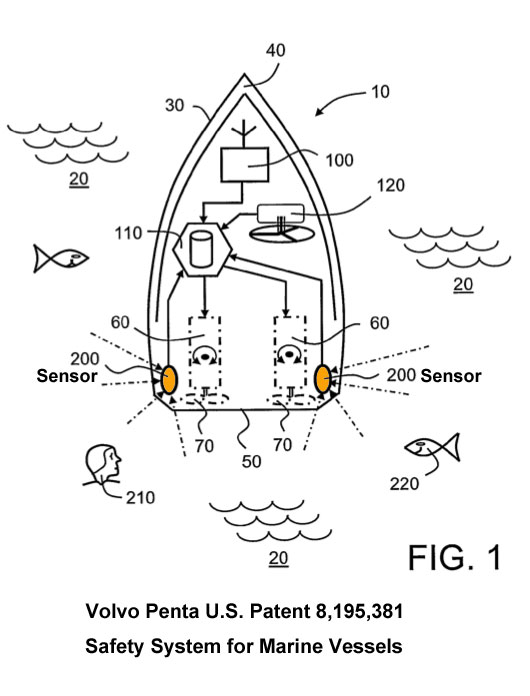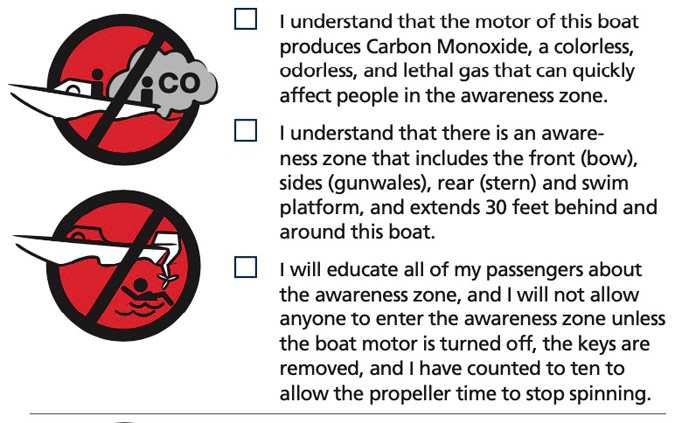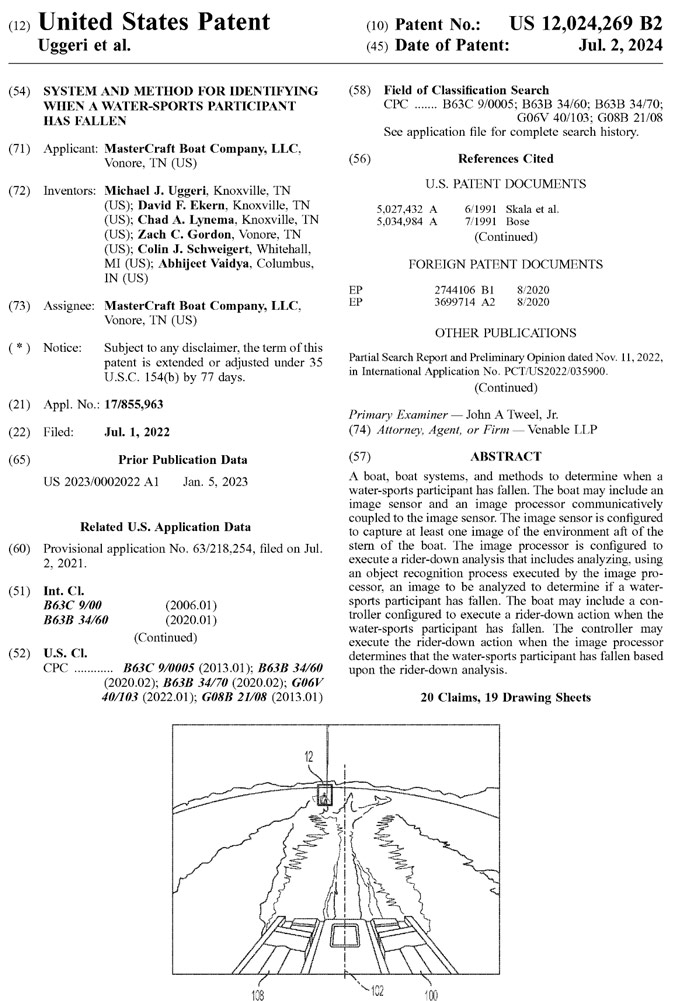Blind Spot Haptic Virtual Propeller Guard Invention
Our invention detects people in the water within the danger zone of boat propeller(s) when engine(s) are running at low RPM and alerts boat operators via a haptic steering wheel.
The disclosure below of our Haptic Blind Spot Virtual Propeller Guard invention was posted on April 3, 2025. We will make no changes to text below the line following this paragraph except to correct misspellings, punctuation, and to update html/computer codes and links. Any updates to the invention itself will be posted below the invention disclosure.
This invention disclosure was posted April 3, 2025.
The Problem to be Solved
Reduce the number of slow speed propeller strikes, especially those involving picking up fallen skiers, wake surfers, wake boarders, and others falling from towed implements and inflatables.
History of Slow Speed Propeller Strikes
Boat propeller accidents have been associated with power boating since the early days. Many propeller accidents result from well known scenarios as described in our, Typical Propeller Accident Scenarios post. The first scenario we listed was, “They were tubing, water skiing, or wakeboarding, fell and ran over by their own boat when it came back to pick them up.” Note, we wrote that post back before wake surfing became popular.
Others Have Long Made Similar Statements
See the quotations below:
- 1979: “Epidemiology of Waterskiing Injuries”. Jon V. Banta MC in The Western Journal of Medicine June 1979 reported, “With the increasing popularity of waterskiing, records of injuries are showing increases in total incidence and fatalities. … Accidents involving propellers remain the chief cause of devastating and mutilating injuries. Medical treatment of these catastrophic injuries should be comparable to the treatment of massive battle wounds ….”
- 1987: The U.S. Coast Guard assigned Edward Purcell and Walter Lincoln of the USCG Research and Development Center to investigate the problem of propeller injuries and identify potential safety measures. Their 1987 final report identified 4 scenarios that account for most propeller iwas “A water skier or fallen passenger is run over during subsequent maneuvering by the operator.”
- 1989: The Coast Guard’s National Boating Safety Advisory Council (NBSAC) 1989 Report of the Propeller Guard Subcommittee stated:
In 2008 the U.S. Coast Guard produced a series of flip charts to be used by facilities renting boats to review boating safety with their clients. One chart focused on what USCG called the Propeller Awareness Zone, the area withing 30 feet of the boat.
Similar Messages Continue Today
See the quotations below:
- 2023: Water Sports Industry Association (WSIA) devoted an entire page of their 2023 handbook to propeller injuries. “Contact with rotating propellers is one of the most dangerous hazards, which occurs from negligence of operators, passengers, towed participants, swimmers, and bystanders. A propeller is designed to travel in the water and rotates at a speed that can cause death if it comes into contact with a human being. Severing, deep lacerations, blood loss, trauma and exposure to microorganisms in the water that enter the bloodstream can result in death or serious injury.”
- 2025: National Marine Manufacturers Association’s (NMMA) website specifically warns skiers, tubers, and wake boarders to Beware Boat Propellers ….. The first safety tip listed under the warning is “People in the water may not be visible from the helm.”
Wake surfing has enjoyed tremendous growth. Covid spurred on towed inflatables as family’s sought the great outdoors. Banana boats are a big hit at camps and excursions. Many still enjoy water skiing and wake boarding. New tow boats carry more people, create larger wakes, and shape those wakes. Their popularity places even more people in the propeller danger zone.
Industry Patents Detecting People Near Propellers
Back in 2002, we coined the phrase, Virtual Propeller Guard. We defined Virtual Propeller Guards as, “A system composed of sensors, decision making capability, actuators and one or more outputs. The system detects potential collisions with objects near or soon to be near a submerged marine propeller about to be engaged or currently engaged.”
Several firms were already designing, patenting, or manufacturing indirect methods to indicate people “MIGHT BE” near the boat propeller. These methods included kill switches, virtual kill switches, ladder switches, and gate switches. They were mostly variants of Operator Protection Systems (OPS) used in other industries.
Then the boating industry began searching for direct methods to detect people “WERE” near the boat propeller. They used infrared detectors, rear facing cameras, tags/fobs, capacitance sensors, radar, sonar, and more.
Well known firms in the boating industry have patented systems to detect people in the water near the vessel. See our 2019 Sensor Based Detection of People Near Boat Propellers: Patents post.
Three Boating Industry Examples
Please note how long these technology based approaches have been around.
Propeller Danger Zone
The 2008 USCG Rental training flip chart above refers to a 30 foot “Awareness Zone” while skiing or engaging in water sports. Many other sources speak of staying clear of boat propellers. Very specific definitions are hard to find. We like the one presented by Serrano Law, “Always maintain a safe distance from the rear and sides of boats and watercraft where propellers are located. Avoid swimming, diving, or engaging in water sports near running engines or propellers.”
The 2008 USCG rental training package referenced above, also included a series of preprinted tear off sheets for different boat types. The Ski / Runabout page included the items below in its checklist for rental facilities to go over with renters. The second and third item define an Awareness Zone.
Those designing Blind Spot Haptic Virtual Propeller Guard Systems will need to define their own Propeller Danger Zone, but the information supplied here should assist them in that process. Versions of this invention may not protect individuals in every square inch of the defined area. However, they could still prevent many boat propeller strikes.
Blind Spots
Boat operators do not always have a designated spotter when towing. When someone falls the boat circles back to pick them up or get the handle back to them. Boat operators lose sight of fallen riders when they turn the boat around. Once the boat is turned around they may not see fallen riders over the bow.
Momentum of the boat, wind, wakes and/or waves may push the boat too close to fallen riders. If the operator pulls past fallen riders to allow them to swim to the stern ladder, they cannot see swimmers in the water due to the transom and/or outboard motor. These blind spot issues can lead to boat propeller strikes. Many operators have left engine(s) running in what they mistakenly think is neutral to pickup fallen riders.
Automobile Industry Technologies With Potential Boat Propeller Safety Applications
The automobile industry faced similar safety challenges to the boating industry. For example:
- Driveway backovers are similar to houseboats backing off beaches into people still in the water
- Automotive style backup cameras are finally being adapted in some facets of the boating industry
- Blind spots are encountered while operating both boats and cars
- Alcohol consumption is an issue for both boat and automobile operators
- Hazardous driving operating conditions correspond to wind, waves, wakes, and tides
- Weather can cause serious safety issues for both cars and boats
- Distracted drivers are a problem for both cars and boats
- Pedestrian detection is similar to detecting people in water near the stern
Blind Spot Technologies
Use of cameras and sensors identifying and detecting people, cars, or objects in their surroundings is ubiquitous in the automobile industry.
Once an person of object is detected in a blind spot, information is transmitted to the driver. This is often done by visual cues (lights in side mirrors), displays and/or alarms.
Several cars communicate blind spot alarms via haptic steering wheels. The steering wheel vibrates, buzzes, or otherwise interacts with the operator’s hands to communicate the danger.
Honda’s U.S. Patent 11,238,671 System and Method for Providing Haptic Alerts Within a Vehicle is an example of many patents in this field.
Hyundai’s 2024 Tucson is an example of current automobiles using haptic steering wheels to alert operators in process of changing lanes to vehicles in blind spots.
Hyundai says, “The steering wheel provides haptic feedback to alert the driver to warnings from the lane-keeping assist and blind-spot monitoring systems. This tactile feedback enhances safety by keeping the driver informed without distracting from the road.”
Many boats have blindspot issues at slower speeds in front of the boat (hard to see over the bow), just to the rear of the operator alongside the boat, and behind the boat. Boat operator view to the rear can be blocked by the stern, by outboard engines, by others on board, or by “stuff” including towables and inflatables on board.
Technologies allowing automobile drivers to “see” around blind spots can be applied to boating.
Detecting When a Skier or Towed Person Falls is a Blind Spot Problem
While marine drive manufacturers were working on detecting people near boat propellers, tow boat builders were working on ways to detect when a skier or towed person fell.
Mastercraft’s 2024 patent below is an example of their approaches.
The Invention
We (Gary Polson, Polson Enterprises, and PropellerSafety.com) claim the propeller safety invention described below and now make a public disclosure of it. We place all parts of this invention not previously patented by others into the public domain for others to use or build upon this work. All we ask is that they cite this invention disclosure.
We claim:
Use of current and/or future techniques for detecting people in the water in the propeller danger zone near the side or stern of the boat OR the probability of people being in the water in or near the propeller danger zone combined with:
- Use of the Engine Control Unit (ECU) to detect the boat engine(s) are not running but are switched to on or are running at a low RPM. A speedometer, tachometer, GPS, accelerometer, detecting when the marine drive is shifted into forward or reverse, and/or the ECU and data already being provided to it could be used individually or in a variety of combinations to verify the boat is at rest or moving slowly.
- A Decision Making Module.
- The Decision Making Module could be freestanding or programmed into the Engine Control Unit (EU) or a combination of both.
- An Alert that people are or may be in the propeller danger zone and the engines are switched on or running at a low RPM.
- The Decision Making Module determines when to activate the alert. Data and variables used to make that decision and how they could be processed are described in the following sections.
- The alert may be delivered in multiple formats, but one of them is by use of a haptic steering wheel.
- The haptic steering wheel or portions of the wheel vibrate to provide an alert
Fallen Rider(s) Features
- Fallen skier technologies that alert the Decision Making Module that someone being towed or wake surfing just fell could also be incorporated. The Decision Making Module could estimate how long it might be before such a person would be in the propeller danger zone and enhance intensity at that time.
- Similar to #1, a fall could be anticipated by the Decision Control Module by recognizing the decrease in load being pulled (less tension on the tow point, increase in engine RPM), recognizing the process of the boat slowing, turning around and going back, then slowing down to anticipate a person might be in the water near the boat. The Engine Control Unit along with a GPS system could supply several variables needed to recognize the pattern. An accelerometer could monitor changes in direction and acceleration.
- Increased probability of someone being in the propeller danger zone could be used to decrease the “score” required to activate the haptic steering wheel.
AI Features
- The Decision Making Module could incorporate Artificial Intelligence (AI).
- AI could be trained to recognize when the boat was being used to tow people.
- The AI could be trained to recognize the vessel going back to pickup one or more persons that had fallen.
- AI could be trained to recognize when the boat changes direction to pickup and fallen skier and when it slows down to pick them up.
- An accelerometer combined with AI and a clock could estimate relative wave height and direction when the boat is at rest or moving slowly. Average wave height over time is an indicator of wind speed on lakes.
- Positive detections when the Decision Making Module thinks the boat is picking up a fallen towed person could carry more weight than those at other times.
Haptic Steering Wheel Features
- The Haptic Steering Wheel can only activated when the boat is at rest or going slow.
- The Haptic steering wheel could be used in combination with more traditional alert/alarm methods such as visual displays, red lights, flashing lights, audio alarms, buzzers, and horns.
- Haptic steering wheels typically use piezoeletrics or eccentric rotating mass to generate vibration
- Automotive haptic steering wheels may need the haptics/vibration to be intensified to provide a similar alert to a boat operator bouncing around on the water
Decision Making Module Features
- Score propeller strike risk with certain go no go settings based upon scoring outputs of various sensors.
- Maintain a record of activations by date and time.
- Store basic information about the boat (size, length, type of boat, type of marine drive such as inboard, stern drive or outboard motor, and horsepower) for use in decision making.
- Use Artificial Intelligence (AI) to improve decision making.
- Use Neural Logic to improve decision making
- Two or more methods of detecting people in the water could be used by the Decision Making Module to reduce false positives and/or false negatives (sensor fusion).
- Requiring positive detections of people in the propeller danger zone or the probability of people being in the danger zone to be repeated two or more times or exist continuously over some period of time before the Decision Making Module activates the haptic steering wheel
- Some or all of connections between sensors and the Decision Making Module could be via a bus or wireless. For example, Brunswick /Mercury Marine’s Smart Craft system.
- Upon detection of people in the water in or near the danger zone or the probability of people being in the danger zone while the engine(s) are running below a low RPM such as 1500 RPM and the boat is at rest or moving slowly, the Decision Module could command the engine(s) throttled back or shut off.
Blind Spot System Features
- A system test button.
- An Override.
- Method to set intensity of steering wheel vibration (haptic feedback).
- Intensity of steering wheel vibration could be varied according to propeller strike probability as determined by the Decision Making Module.
- Means to inform boat operators of the system, how it works, how to test it, and how to override it. Such means might be a manual, a decal, a QR code, use of existing visual displays, or other means,
Additional Safety for Specific Boat Propeller Accident Scenarios
In addition to traditional towed propeller strikes, the Haptic Blind Spot Virtual Propeller Guard provides a level of protection in some unique situations.
- Sometimes those onboard jump off the stern area to assist others, retrieve a rope, or relieve themselves.
- Those onboard may fall over the stern area.
- A towed or about to be towed individuals become entrapped in a tow rope that is being pulled into the propeller. Some individuals have finger, hands, or arms very severely injured or amputated, others are pulled in and struck by the propeller. This system could alert boat operators a person was in the danger zone before they could be pulled in by a rope.
- Banana Boat propeller accidents. Several people are often riding banana boats at once. Boat operators or spotters may not recognize when someone falls. This has led to several propeller strike fatalities, most notably the U.K. Princess Club Water Sports death of Mari-Simon Cronje in 2010.
Additional References
- Boat and Propeller Impact Injuries and Fatalities. Project 763584.20 Final Report. 1 March 1987. Edward S. Purcell and Walter B. Lincoln. U.S. Coast Guard Research and Development Center. Groton, Connecticut. 1 March 1987.
- Report of the Propeller Guard Subcommittee. National Boating Safety Advisory Council. Presented November 7, 1989.
The END
Any future related information will be posted below this line.
***********************
